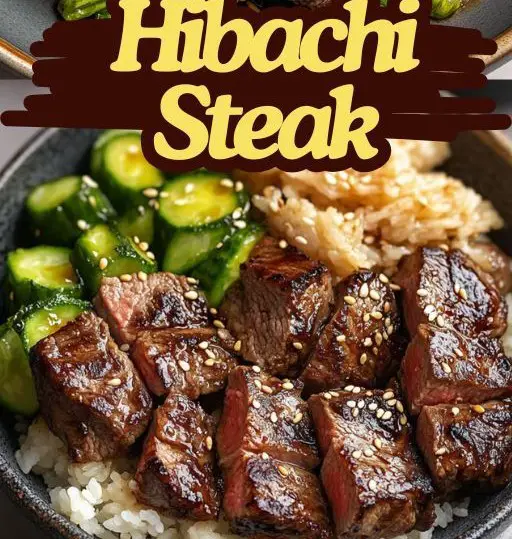Bring the Japanese steakhouse experience to your own kitchen with this savory Hibachi Steak recipe. This one-pan dish features tender, bite-sized steak, sautéed vegetables, and a flavorful savory-sweet sauce that’s both comforting and exciting. Whether you’re cooking for a casual dinner or a special occasion, this quick and satisfying meal is sure to impress.
Ingredients
-
1 pound sirloin or NY strip steak, cut into bite-sized pieces
-
2 tablespoons vegetable oil, divided
-
1 teaspoon sesame oil
-
8 ounces white mushrooms, sliced
-
1 large onion, sliced
-
2 zucchinis, cut into ½-inch sticks
-
2 tablespoons butter, divided
-
4 cloves garlic, minced
-
¼ cup soy sauce
-
1 tablespoon mirin (Japanese sweet rice wine)
-
1 teaspoon honey
-
Salt and pepper, to taste
-
Sesame seeds and sliced green onions, for garnish
Directions
-
Prepare the steak:
Season the steak pieces with salt and pepper. -
Cook the steak:
Heat 1 tablespoon of vegetable oil in a large skillet or wok over medium-high heat. Add the steak and sear for 2–3 minutes per side until browned. Remove and set aside. -
Sauté vegetables:
Add the remaining vegetable oil and sesame oil to the pan. Add sliced mushrooms and onions; sauté for 4–5 minutes until softened. Add zucchini and cook for an additional 2–3 minutes. -
Add garlic:
Push the vegetables to the side of the pan. Melt 1 tablespoon of butter and add the minced garlic. Sauté for 30 seconds until fragrant. -
Make the sauce:
In a small bowl, mix soy sauce, mirin, and honey. Pour the sauce into the pan with the vegetables. -
Combine and simmer:
Add the cooked steak back into the pan. Stir everything together and simmer for 1–2 minutes until the sauce slightly thickens. Add the remaining tablespoon of butter and stir to melt. -
Serve:
Remove from heat. Garnish with sesame seeds and sliced green onions. Serve hot with hibachi fried rice and yum yum sauce, if desired.
Nutrients (Per Serving)
-
Calories: 352 kcal
-
Carbohydrates: 12 g
-
Protein: 32 g
-
Fat: 20 g
-
Saturated Fat: 7 g
-
Cholesterol: 82 mg
-
Sodium: 939 mg
-
Potassium: 585 mg
-
Fiber: 3 g
-
Sugar: 6 g
-
Vitamin A: 72 IU
-
Vitamin C: 24 mg
-
Calcium: 46 mg
-
Iron: 3 mg
What Is Hibachi?
The term hibachi originally refers to a traditional Japanese heating device—essentially a container with charcoal used for heating or cooking. In Japan, the term for what Westerners know as “Hibachi” cooking is actually teppanyaki, which involves grilling food on a flat iron surface. The confusion likely stems from American interpretations of Japanese dining during the post-war era, when hibachi grills gained popularity in restaurants that emphasized theatrical, communal cooking.
Today, when we say hibachi steak, we’re referring to the sizzling, seared beef commonly served at Japanese-American steakhouses like Benihana. These meals typically involve sliced steak, vegetables like onions, mushrooms, and zucchini, and flavorful sauces, all cooked in front of diners on a large flat grill. The excitement is in both the flavors and the performance.
Why Make Hibachi Steak at Home?
While dining at a hibachi restaurant is undeniably fun, it’s not always the most practical or economical choice for a weeknight meal or a quiet evening at home. Making hibachi steak in your own kitchen allows you to enjoy restaurant-quality flavor while customizing the dish to your personal tastes and dietary needs.
Here are a few reasons why this recipe is worth trying:
-
Quick and simple: Despite its rich flavors, hibachi steak requires minimal ingredients and can be made in under 30 minutes.
-
Customizable: You can control the sodium level, switch up the vegetables, or adjust the sweetness and intensity of the sauce.
-
Meal-prep friendly: It stores well in the fridge and can be repurposed into rice bowls, wraps, or even salads.
-
Kid- and family-friendly: Its balance of savory, sweet, and umami flavors makes it appealing to a wide range of palates.
The Key to Flavor: The Hibachi Sauce
What makes hibachi steak truly unforgettable is the sauce—a savory blend of soy sauce, mirin, honey, and garlic. This umami-rich combination coats the meat and vegetables, transforming simple ingredients into a vibrant, cohesive dish. The sauce is typically just a bit sweet and slightly tangy, with the garlic providing warmth and depth. The butter stirred in at the end gives it a luscious finish that clings to every bite.
If you’re watching your sugar intake, the honey can be reduced or substituted with a sugar-free sweetener or even a bit of orange juice for natural sweetness. For a deeper flavor profile, a splash of rice vinegar or a teaspoon of freshly grated ginger can be added to the sauce.
Choosing the Right Cut of Steak
For a successful hibachi steak, the quality and cut of the beef matter. Sirloin and New York strip are the most commonly used cuts for this recipe. They strike a good balance between tenderness, flavor, and affordability. Ribeye can be used for a fattier, more decadent version, while filet mignon offers exceptional tenderness for special occasions.
Whichever cut you choose, it’s important to slice the steak into uniform, bite-sized pieces. This ensures even cooking and helps the sauce coat the meat thoroughly. High heat is crucial—searing the steak quickly helps to develop that delicious crust while keeping the inside juicy.
Vegetables: A Supporting Star
No hibachi meal is complete without a medley of sautéed vegetables. In this recipe, mushrooms, onions, and zucchini are the vegetables of choice. Together, they offer a satisfying variety of textures and flavors—earthy mushrooms, sweet caramelized onions, and the tender crunch of zucchini.
However, this combination is highly flexible. Bell peppers, broccoli, carrots, or snap peas can easily be added based on what you have on hand or prefer. The vegetables not only balance the richness of the steak but also add vibrant color and important nutrients like fiber, vitamin C, and potassium.
Serving Suggestions
Traditionally, hibachi steak is served with sides that elevate the meal into a complete dining experience. Here are a few pairings that bring the full hibachi restaurant vibe to your table:
-
Hibachi Fried Rice: Made with day-old rice, scrambled egg, diced veggies, soy sauce, and a bit of butter for richness.
-
Yum Yum Sauce: A creamy, tangy dipping sauce made with mayonnaise, ketchup, garlic powder, and a hint of sugar and paprika.
-
Miso Soup or Clear Soup: As a light starter, these classic Japanese soups balance the heavier main dish.
-
Steamed White or Brown Rice: A simple, healthier alternative to fried rice.
To serve, consider garnishing your steak and vegetables with sesame seeds and thinly sliced green onions for visual appeal and a subtle burst of freshness.
Health and Nutritional Perspective
Though hibachi steak feels indulgent, it can be a balanced meal when prepared thoughtfully. With lean cuts of beef, minimal oil, and a good amount of vegetables, it’s high in protein and moderate in healthy fats. The calorie content per serving is around 352 kcal, with 32 grams of protein—great for muscle maintenance and satiety.
One thing to be mindful of is sodium, especially from soy sauce. Using a low-sodium version can significantly reduce the salt content without sacrificing too much flavor. For those following a low-carb or keto diet, this dish is naturally low in carbs (around 12 grams per serving), and the rice can be swapped with cauliflower rice for an even lighter option.
Variations to Explore
While the classic version of hibachi steak is always a hit, there are plenty of ways to adapt the recipe to suit different preferences or dietary needs:
-
Hibachi Chicken or Shrimp: Substitute steak with boneless chicken thighs or peeled shrimp. Both cook quickly and absorb the sauce beautifully.
-
Vegan Hibachi: Use tofu or tempeh in place of meat, and replace the butter with plant-based alternatives.
-
Spicy Hibachi: Add a dash of sriracha or crushed red pepper flakes to the sauce for heat.
-
Pineapple Twist: For a sweet-savory twist, toss in a few chunks of pineapple during the last few minutes of cooking.
These small changes can keep the meal exciting and help cater to a wider range of diets.
Conclusion
Hibachi Steak is more than just a recipe—it’s a gateway to enjoying the spirit of Japanese teppanyaki-style cooking right in your own home. With minimal ingredients and a simple cooking process, this dish delivers bold flavor, enticing textures, and plenty of room for personalization. Whether you’re recreating a restaurant favorite, feeding a family, or meal-prepping for the week, hibachi steak provides a satisfying, balanced meal with both flair and substance.
It’s a reminder that great food doesn’t have to be complicated, and that the experience of cooking—hearing the sizzle, inhaling the aromas, and seeing the glossy sauce coat every piece—is part of the joy. Bring out your inner chef, fire up the skillet, and enjoy your own hibachi night at home.






